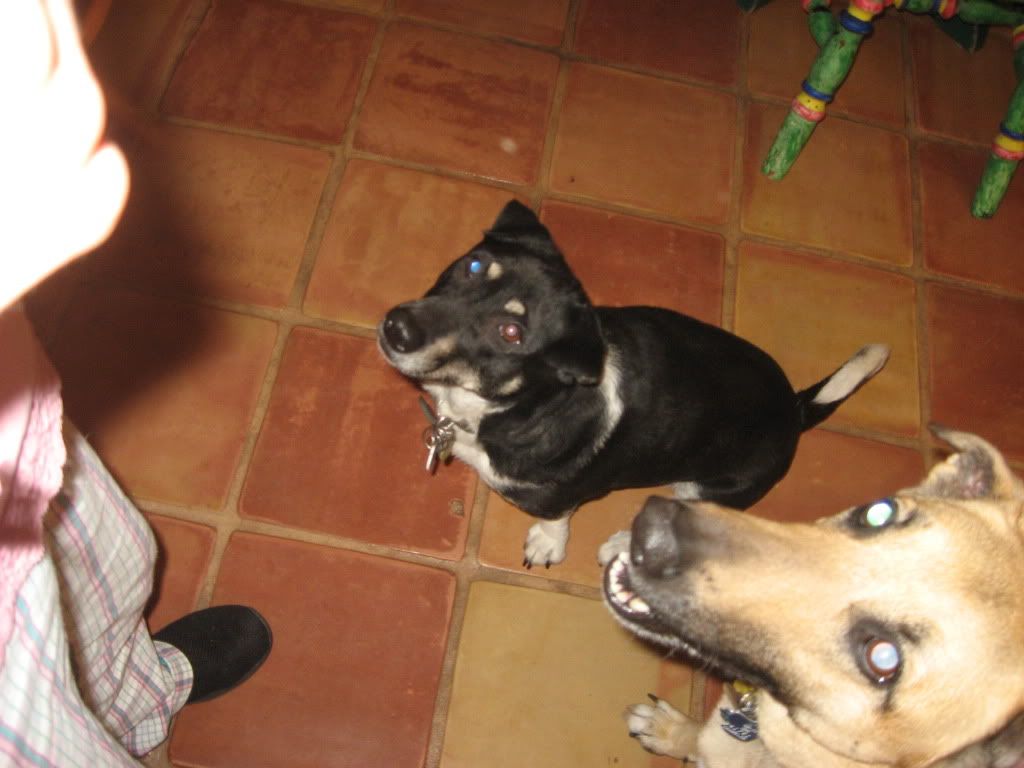
Above: My pal gets coaching with her two dogs.
I’ve been at Mandalay Shores over the holiday staying with a friend and my nieces and nephews–3 dogs and 8 cats.
Usually I spend hours out on the beach walking for miles and enjoying the wildlife.
However this trip was a little different.
My pal has been complaining that her dogs are super out of control and aggressive to other people and animals.
The dogs happen to be clicker phobic (except for the German Shepherd mix) so I use my voice and have been spending time with all the critters.
The cats all sat around and watched as the dogs began school.
It was funny.
Only one feline wanted to join in the school session–the rest consider it enrichment.
Imagine the surprise of my pals when I ambled out with the dog trio and came back to report that the girls were good.
Well, almost good.
They did act up but quickly responded when I told them to stop and asked them to sit instead.
Often, using an incompatible behavior replaces the one you don’t want.
In this case, a sit solves many problems. The behavior
- allows the dogs to watch,
- calms them down,
- stops them from leaping and lunging,
- reduces the frothing at the mouth,
- and eliminates barking or growling.
I’ve walked the dogs every day that I’ve been here.
Now they know that they need to sit if a dog or person approaches and when in doubt–they choose to sit.
Sometimes they need prompting but they all enjoy treats and being told that they are “good dogs” instead of entering into the drama that ensues otherwise.
The funny thing is that everyone in the neighborhood knows and avoids the trio.
So when I walk them I am sort of like a neighborhood celebrity…people smile and wave.
And those that used to cross the street with their dogs just keep walking and break out in big grins as they pass.
Now I don’t take any chances but I am amazed at how unwilling people are to change their behaviors.
For instance, we were walking up a narrow path when a big dog lunged at the fence and gate.
At the time I had two of my charges with me.
They were spooked but I moved to the side of the path and asked them to sit because I wanted them to be calm in that situation.
PLUS I saw two bicycle riders coming toward us.
Neither of the bicyclists had the sense to slow down or stop despite seeing the startled dogs.
If the dogs went off as they apparently have in the past, and if they were not under control, the additional stress would have sent them over the edge and possibly knocked over one of the riders.
As it was, the girls were jumpy because they had two dynamics present that each alone would have triggered a frenzy–never mind the double dose of stress.
My calmness and their new behavior helped–but it was a bit much for them.
They did great.
But it got me to thinking when it comes to animals out in public–whose fault is it if there is an incident?
My pals are dog lovers and do whatever it takes for their animals but they don’t expect them to behave nor do they teach them what constitutes good manners–and so they are wild–except for with me.
This is a problem I see escalating when I think it would be getting better.
Now most dog owners would be found at fault for failure to control their dogs. If you fail to pay attention, things happen that second you are distracted.
BUT what about those people who fail to adapt their behavior to adjust for the presence of a dog?
Could they also be at fault?
You’d have to get into the dog laws of the area and the specific circumstances to get a real answer but my point is that animal problems are usually a people problem.
If there is anything people should know (and keep at the front of their minds) it is that animals can be unpredictable.
So in the scheme of things we all should be more attentive to animals and slow down our vehicles or adjust our pace as we approach critters.
If more humans adjusted their behavior and developed better animal sense it might be better for everyone.
In the meantime, I hope my pals will adapt their behaviors to keep the better pet behavior going.
At any rate it will be interesting to hear what the neighbors have to say!
Do you have any thoughts on the matter? If so, please comment below.


